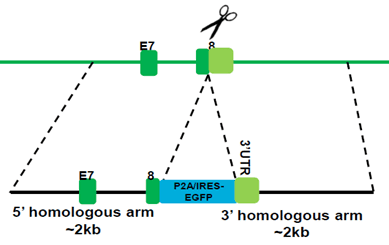When conducting a study, there are often intermediate experiments that require tracking or monitoring gene expression. Analogous to general knockin/knockout mice, we help researchers insert reporter genes into precise predetermined regions of the genome under the control of certain promoters.
One way to “tag” certain genes is through introducing an exogenous gene that is easily detected, whether through a color change based on metabolic compounds (like LacZ), fluorescent proteins (such as GFP), or through protein tags (such as FLAG). Tag, or reporter genes, often carry a function that is useful for a specific experimental design, which will help dictate which locus to insert in.
For example, mouse models can be used to mimic human genetic diseases when mutation(s) are introduced. To generate a knockin mouse model, a DNA fragment of interest is inserted at the desired location in the genome. This modality allows for a variety of models to be created including point mutation, reporter (GFP), tagged (FLAG), Cre, and humanized mice.
Wild-type and/or mutant genes tagged with EGFP, YFP, LacZ, Flag, mCherry and other sequences are useful for monitoring gene expression. Reporter gene mouse models can be used to construct phylogenetic trees for cell development studies. Replacement of an endogenous gene with a reporter can simultaneously achieve gene knockout and knockin in the same mouse model.

Request a Quote
Contact us today to find out how we can help advance your research with custom generated rat, mouse or cell line models.



